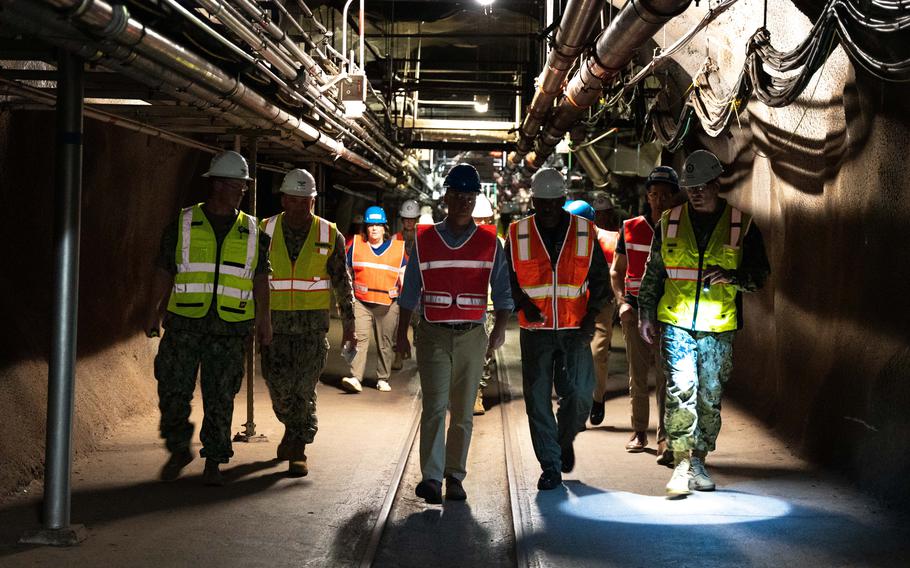
Under Secretary of the Navy Erik K. Raven receives a guided tour of the Red Hill Bulk Fuel Storage Facility (RHBFSF) from members of Joint Task Force-Red Hill (JTF-RH) on Jan. 11, 2024. (John Linzmeier/Department of Defense)
HONOLULU (Tribune News Service) — The military began removing residual fuel from the Navy’s underground Red Hill Fuel Farm on Monday, marking the beginning of the next phase of the facility’s closure.
The start of residual fuel removal coincides with the establishment of the Navy Closure Task Force-Red Hill. From now until the end of March, the task force will work in conjunction with the existing Joint Task Force-Red Hill to “ensure continuity of mission for safety, security and community engagement,” according to a news release, before it eventually oversees the long-term closure and environmental remediation of the facility, which sits 100 feet above an aquifer that most of Honolulu relies on for drinking water.
“We’re starting a deliberate methodical transition with the new Navy Closure Task Force,” said Vice Adm. John Wade, commander of JTF-RH, the organization tasked with extracting fuel from the facility. “They’re tied to our hip and learning from us for everything that we’re doing for safety, security and community engagement to ensure continuity of mission when we secure our task force, and they will take this mission on.”
JTF-RH safely removed approximately 104 million gallons of fuel through “gravity defueling” from Oct. 16 to Dec. 16. Throughout the gravity defueling process, Wade said that there were no spills and that there were only two minor incidents, in which the three gallons of leaked fuel was contained in buckets.
In removing an additional 60,000 gallons of residual fuel, or “fuel that couldn’t be removed from gravity,” JTF-RH is taking a “methodical and deliberate approach.” JTF-RH will slowly open “low point drain” and vent valves to contain, collect and properly dispose of the fuel. The process is expected to be completed by the end of March.
“Every action is practiced; and every action has been reviewed and approved by the regulators; and the regulators are on-site providing oversight,” Wade said. “That’s critically important so that we ensure safety of our personnel but, most importantly, the safety of the community and the aquifer.”
The new Navy Closure Task Force will remove an additional 4,000 gallons of residual fuel in the pipelines and 28,000 gallons of sludge remaining in storage tanks. The organization will also remove all of the approximately 11.5 miles of pipeline from the site.
In late March the NCTF-RH will assume full responsibility for the facility, its closure and long-term environmental remediation.
“We are committed, we are going to do this deliberately, we’re going to be engaged with the community, and we’re going to do it safely,” said Rear Adm. Stephen Barnett, who will lead NCTF-RH.
Barnett said the closure of the tanks will take years and that remediation efforts will stretch even after the closing of the tanks and will be driven by a site assessment and understanding “actually what has happened over the years at Red Hill.”
“It is not going to be used for fuel again. Ultimately, our job is just to close it and set the conditions for any potential nonfuel reuse, so that’ll be decided at a later time,” Barnett said.
Remediation could take many forms, and Barnett said that after monitoring and understanding the situation, the task force will work with experts including regulators, the Department of Health, the Environmental Protection Agency and members of the local community to decide how to move forward.
For years the community has been wary of the Navy’s Pacific fuel reserve being located above the aquifer, worrying about the potential threat it held over Honolulu’s water supply.
In November 2021, fuel from the facility leaked into the Navy’s Oahu water system, affecting 93,000 people, including service members, military families and civilians who live in housing areas still on the system. In March 2022 the Pentagon announced it would defuel and permanently close the facility after months of resisting a state emergency order to drain the tanks.
“Clean water is an important aspect of the entire Red Hill problem set,” Wade said. “My team and I’s contribution to that is to remove the fuel from above the aquifers so we have no spills and no other contamination like we had in 2021.”
Barnett said long-term monitoring of Red Hill water quality has been in place and that over 7,000 samples have met safe drinking water standards. When the long-term monitoring period ends in March, Barnett said, other test methods and opportunities to continue testing the water supply will be implemented.
“There’s no one more committed than us, along with the Joint Task Force. We’re committed to providing safe, clean drinking water for our families and folks that are all in the water system here. We’re going to do what we can,” Barnett said. “We’re in the long-term monitoring process, and that water continues to meet the safe drinking water standards but we’re not resting on that.”
(c)2024 The Honolulu Star-Advertiser
Visit at www.staradvertiser.com
Distributed by Tribune Content Agency, LLC.